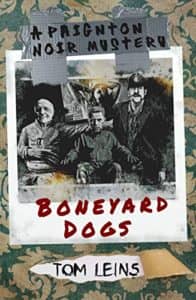If you are desperate enough to hire Paignton private investigator Joe Rey, things have already gone from bad to worse – and a happy ending is highly unlikely. Hired to track down the missing teenage daughter of a demented local lounge singer, Rey’s investigation spirals bloodily out of control, and he finds himself surrounded by the ruined corpses of dead people traffickers. The police are determined to pin the murders on the hapless PI, but as his search unfolds it becomes apparent that the culprit may actually be a man he knows all too well…
Nearly all of my e ncounters with noir and crime fiction have been explicitly linked to horror– from the relatively lighthearted Dresden Files to the drearier Felix Castor series, there’s no denying that the dark and gritty gumshoe style fits well with horror tropes. I mention these not because Tom Leins’ new novel (novella?) Boneyard Dogs fits into the horror noir crossover subgenre, but because it managed to capture and hold my attention just as well as those series without truly touching horror at all. Given that I generally have no interest at all in pure crime fiction or mystery this may be something of a feat, and I think it’s thanks largely to Leins’ extremely stylized setting and quick, direct narration.
ncounters with noir and crime fiction have been explicitly linked to horror– from the relatively lighthearted Dresden Files to the drearier Felix Castor series, there’s no denying that the dark and gritty gumshoe style fits well with horror tropes. I mention these not because Tom Leins’ new novel (novella?) Boneyard Dogs fits into the horror noir crossover subgenre, but because it managed to capture and hold my attention just as well as those series without truly touching horror at all. Given that I generally have no interest at all in pure crime fiction or mystery this may be something of a feat, and I think it’s thanks largely to Leins’ extremely stylized setting and quick, direct narration.
The novel takes place in Paignton, here written as a run-down stretch of dive bars and pay by the hour hotels in the UK. Paignton feels grimy– it’s as though the entire place is a urine-soaked back alley in the middle of the night where the only thing that shines is the occasional used hypodermic needle caught just right by the moon. It’s interesting to see this amount of sleaze and filthiness applied to the UK, as so often in fiction everything across the pond is depicted as beatific and quaint. The occupants of Paignton are much the same, and though they were often caricatures they were usually over the top enough to entertain without overstaying their welcome. Think Sin City under a fine layer of sludge and you’ll be on the right track.
Boneyard Dogs is also a lightning-fast read. The book is incredibly short, clocking in at under one hundred and fifty pages, but Leins’ ability to weave details and imagery into even the most mundane of sentences makes the story feel far more developed than anything so short has any right to be. What’s more, the pace of Boneyard Dogs isn’t based on the length alone, but on the writing. It would be incorrect to say the story moves at a decent clip– this thing takes off at a full sprint and doesn’t stop until it barrels right off the proverbial cliff like a lemming hellbent on self-destruction. The speed of Leins’ writing gives you no choice but to hang on and wait for the ride to come to a stop.
Unfortunately, the stop itself is a little jarring. The ending is the only part of Boneyard Dogs which actually feels rushed. While I appreciate that the narrative is meant to accelerate into the climax, the climax itself is a little too short and didn’t feel quite like the reveal at the end of a mystery should– I wasn’t left with the impression that this was written to be a major reveal, but that the antagonists were essentially the antagonists the entire time. Also, without dipping into spoilers, the ending is a bit too transparent. Were all as it has been presented, there would be plot strands which ultimately served no purpose, and in such a short title that seems unlikely. Regardless, this is an easy recommendation not only for fans of crime fiction but for those horror fans who delight in both the vulgar and the visceral.
Boneyard Dogs is available now
One Comment
Comments are closed.








Hi Kyle, many thanks for the great review of Boneyard Dogs! The feedback is much appreciated!